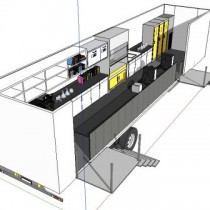The client plays the most important role in the logo creation, primarily because you want to exude their values and what they believe in. It’s important for any professional design company to begin by researching their client then asking detailed questions, learning as much as possible about what they want to deliver through their brand. These elements—that is, their culture, values, and who they are—need to be employed in the logo design itself.
Know the Customer
The client is only as good as their success, so go to their customer and ask them what they feel the company portrays. After you gather some information, bring it back to the company and ensure everyone is on the same page. Once you are familiar with their audience, you’ll have more ideas to morph into their logo. A gardening company, music streaming business, or town website will all have very different audiences, along with different elements they want to bring to their customers and visitors.
Know the Competition
It is just as important for you, the professional, to know and understand the client’s competitor, as it is for the client to know. Just like when you seek out the customer, do the same for the competitor. Ask the client what they know, then do your own research to round it out. You want to know who is already out there and what they are doing, and be sure to set your own ideas apart.
Know its Use
So when is this logo actually going to be used? The designers need to know how it might be broadcasted. Bilboards, websites, and food trucks will all have different uses and ways that the clients implement the logo. Similarly, the shape and space will differ whether the business is solely online or found on a small piece of merchandise. Online-based companies also might need to utilize different color schemes, or black and white might be preferable for those who often need to photocopy important documents.
Know Your Craft
When you are quoting your client, barter a timeline if needed. If you know, for success, you need a lengthier time frame in order to get the job done, then tell them that. Likely, unless they are under a very sensitive deadline, they will be happier to have a better outcome and a more detailed logo, then sending it back multiple times because you lacked the time to be thorough enough in the first steps. Though be honest with yourself—each company needs to be prioritized, and you should focus on the task at hand and get the job done efficiently.
Know Their Needs
The company will likely not know exactly what they want, but know what they want once they see it. After you finish sketching some drafts, present them with about five of your best pieces, and ensure that nothing is similar floating around the market. Don’t add too much detail that will take up time; instead, keep things simple for the client to narrow it down, and then add to it from there.
Know What to Add
Refining the logo for the company is likely the longest step. It is here where you’ll add the detail, and have the company portrayed the best way possible. You’ll add color and fine details, and you can even test run the new logo—depending on its use—to see how it fares in the “real” world.
Know How to Market
In some cases, this step might not be necessary, and taken over by the company themselves. But a good designer can make suggestions on what they could add or how they can change it with simple adaptations to make a brand that will last in any situation. For example, a large logo on a restaurant may work well to attract customers, but a smaller version without many frills and just the name of the business may be best for the top of a menu. The website might require a version in the shape of a square, while a billboard might have room for a lot of additional ornamentation.















